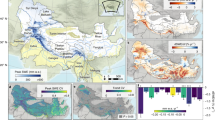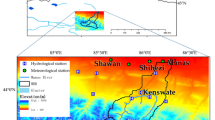Abstract
Precipitation from the Eastern Sierra Nevada watersheds of Owens Lake and Mono Lake is one of the main water sources for Los Angeles’ over 4 million people, and plays a major role in the ecology of Mono Lake and of these watersheds. We use the Variable Infiltration Capacity (VIC) hydrologic model at daily time scale, forced by climate projections from 16 global climate models under greenhouse gas emissions scenarios B1 and A2, to evaluate likely hydrologic responses in these watersheds for 1950–2099. Comparing climate in the latter half of the 20th Century to projections for 2070–2099, we find that all projections indicate continued temperature increases, by 2–5 °C, but differ on precipitation changes, ranging from −24 % to +56 %. As a result, the fraction of precipitation falling as rain is projected to increase, from a historical 0.19 to a range of 0.26–0.52 (depending on the GCM and emission scenario), leading to earlier timing of the annual hydrograph’s center, by a range of 9–37 days. Snowpack accumulation depends on temperature and even more strongly on precipitation due to the high elevation of these watersheds (reaching 4,000 m), and projected changes for April 1 snow water equivalent range from −67 % to +9 %. We characterize the watershed’s hydrologic response using variables integrated in space over the entire simulated area and aggregated in time over 30-year periods. We show that from the complex dynamics acting at fine time scales (seasonal and sub-seasonal) simple dynamics emerge at this multi-year time scale. Of particular interest are the dynamic effects of temperature. Warming anticipates hydrograph timing, by raising the fraction of precipitation falling as rain, reducing the volume of snowmelt, and initiating snowmelt earlier. This timing shift results in the depletion of soil moisture in summer, when potential evapotranspiration is highest. Summer evapotranspiration losses are limited by soil moisture availability, and as a result the watershed’s water balance at the annual and longer scales is insensitive to warming. Mean annual runoff changes at base-of-mountain stations are thus strongly determined by precipitation changes.






Similar content being viewed by others
References
Auger P, Parra RB, Poggiale JC, Sánchez E, Sanz L (2008) Aggregation methods in dynamical systems and applications in population and community dynamics. Phys Life Rev 79–105
Barnett TP, Adam JC, Lettenmaier DP (2005) Potential impacts of a warming climate on water availability in snow-dominated regions. Nature 438:303–309. doi:310.1038/nature04141
Cherkauer KA, Lettenmaier DP (2003) Simulation of spatial variability in snow and frozen soil. J Geophys Res 108(D22):8858. doi:10.1029/2003JD003575
Cherkauer KA, Bowling LC, Lettenmaier DP (2003) Variable Infiltration Capacity (VIC) cold land process model updates. Glob Planet Chang 38(1–2):151–159
City of Los Angeles Water Supply Action Plan, 2008, Securing L.A.’s water supply. On the Internet at http://mayor.lacity.org
IPCC (Inter-governmental Panel on Climate Change) (2007) Climate change 2007: The physical science basis. Contribution of Working Group I to the Fourth Assessment Report of the IPCC (Solomon S, Qin D, Manning N, editors)
Costa-Cabral M, Coats R, Reuter J, Riverson J, Sahoo G, Schladow G, Wolfe B, Roy SB, Chen L (this issue) Climate variability and change in mountain environments: some implications for water resources and water quality in the Sierra Nevada (USA). Clim Chang, this issue
Hawkins E, Sutton R (2010) The potential to narrow uncertainty in projections of regional precipitation change. Clim Dyn 37:407–418. doi:10.1007/s00382-010-0810-6
Howat IM, Tulaczyk S (2005) Climate sensitivity of spring snowpack in the Sierra Nevada. J Geophys Res 110:F04021. doi:10.1029/2005JF000356
Jeton AE, Dettinger MD, LaRue Smith J (1996) Potential effects of climate change on streamflow, eastern and western slopes of the Sierra Nevada, California and Nevada. USGS Report 95-4260
Liang X, Lettenmaier DP, Wood EF, Burges SJ (1994) A simple hydrologically based model of land surface water and energy fluxes for GSMs. J Geophys Res 99(D7):14415–14428
Lundquist JD, Loheide SP (II) (2011) How evaporative water losses vary between wet and dry water years as a function of elevation in the Sierra Nevada, California, and critical factors for modeling. Water Resour Res 47, W00H09. doi:10.1029/2010WR010050
Maurer EP, Brekke LD, Pruitt T, Duffy PB (2007a) Fine-resolution climate change projections enhance regional climate change impact studies. Eos Trans Am Geophys Union 88(47):504. doi:510.1029/2007EO470006
Maurer EP, Stewart IT, Bonfils C, Duffy PB, Cayan D (2007b) Detection, attribution, and sensitivity of trends toward earlier streamflow in the Sierra Nevada. J Geophys Res 112(D11118). doi:11110.11029/12006JD008088
Milly PCD (1994) Climate, soil water storage, and the average annual water balance. Water Resour Res 30(7):2143–2156
Milly PCD, Dunne KA (2002) Macroscale water fluxes 2. Water and energy supply control of their interannual variability. Water Resour Res 38:1206. doi:1210.1029/2001WR00760
Nakicenovic N et al. (2000) Special Report on Emissions Scenarios: A Special Report of Working Group III of the Intergovernmental Panel on Climate Change, Cambridge University Press, Cambridge UK, 599 pp. Available at: http://www.grida.no/climate/ipcc/emission/index.htm
Silberstein M (2002) Reduction, emergence and explanation. In: The Blackwell Guide to the Philosophy of Science. Blackwell Publishers, Malden MA, USA, pp 80–107
Sivapalan M, Thompson SE, Harman CJ, Basu NB, Kumar P (2011) Water cycle dynamics in a changing environment: improving predictability through synthesis. Water Resour Res 47:W00J01
Vogel RM, Wilson I, Daly C (1999) Regional regression models of annual streamflow for the United States. J Irrig Drain Eng 125:148–157
Wilson JS (2010) Blazing new paths for interdisciplinary hydrology. Eos Trans Am Geophys Union 91(6):53–64
Acknowledgments
We thank the Los Angeles Department of Water and Power (LADWP) for climatological and hydrologic datasets required for model calibration and evaluation. This work was performed under contract with LADWP. The opinions expressed in this work are those of the authors and not necessarily of LADWP. Comments by three anonymous reviewers have improved the quality of this paper and are gratefully acknowledged.
Author information
Authors and Affiliations
Corresponding author
Additional information
This article is part of a Special Issue on Climate Change and Water Resources in the Sierra Nevada edited by Robert Coats, Iris Stewart, and Constance Millar.
Electronic supplementary material
Below is the link to the electronic supplementary material.
ESM 1
(DOCX 5107 kb)
Rights and permissions
About this article
Cite this article
Costa-Cabral, M., Roy, S.B., Maurer, E.P. et al. Snowpack and runoff response to climate change in Owens Valley and Mono Lake watersheds. Climatic Change 116, 97–109 (2013). https://doi.org/10.1007/s10584-012-0529-y
Received:
Accepted:
Published:
Issue Date:
DOI: https://doi.org/10.1007/s10584-012-0529-y




